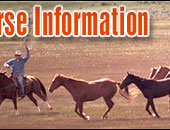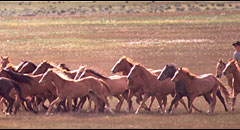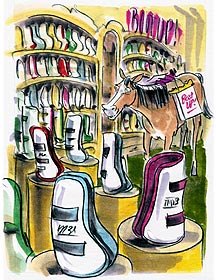 |
   |
|
|
|
You are here: Horses > Horse care > Types of Horse Boots |
Getting The Right Horse Boots For the Job
Your horse needs boots. Before you jump into the incredible variety
available—skid boots, splint boots, interference boots, bell boots and ankle
boots—and to avoid the confusion of trying to decide between these and all the
combinations available, you should decide just what you need the boots to do.
|
|
|
For example, if your horse will be
standing on a shifting surface for a long period of time, shipping boots are
ideal. They’re designed for maximum protection in these situations, and the best
ones will cover the horse’s leg from the knee or hock all the way to the ground.
However, they are only useful for exactly what their name implies—shipping and
standing only. If your horse requires a boot to protect it during work, choose
one designed for movement. Splint boots, covering the inner aspect of the leg
from just below the knee to the ankle, will protect your horse’s legs |
from blows from its other leg. They’re also good for
preventing cuts and scrapes during jumps or cross-country rides. If your horse
needs to feel a rub when jumping, choose an open-front design. For disciplines
that require repeated sliding stops, consider skid boots. These protect your
horse’s fetlocks during these maneuvers. If you prefer to leave the lower leg as
bare as possible, choose ankle or interference boots. These protect the ankle
and fetlock without covering the remainder of your horse’s lower leg. from its other leg. They’re also good for
preventing cuts and scrapes during jumps or cross-country rides. If your horse
needs to feel a rub when jumping, choose an open-front design. For disciplines
that require repeated sliding stops, consider skid boots. These protect your
horse’s fetlocks during these maneuvers. If you prefer to leave the lower leg as
bare as possible, choose ankle or interference boots. These protect the ankle
and fetlock without covering the remainder of your horse’s lower leg.
Bell boots and overreach boots help to protect the bulb of the heel and the
lower pastern. These boots will sometimes prevent sprung or lost shoes. Bell
boots come in a pull-on style which is useful for riding. However, remember
safety. If your horse will wear bell boots when it is unsupervised in the
pasture, make sure to use a style with Velcro closures. This will allow the
horse to get free of them if they become entangled.
Boots are also available in many different materials. From traditional leather
to high-tech composite materials, and lined with anything from natural fleece to
nylon, even the fastenings vary—buckles, snaps, and Velcro. The higher-tech the
materials, the more the boots will cost, but before you let price become your
deciding factor, consider the amount of time and effort you want to spend
maintaining the boots, as well as the time it takes to apply and remove them.
For example, leather splint boots with buckles and fleece linings take longer to
apply and remove, and if they become dirty, they can be difficult to clean.
However, a more expensive set made with neoprene and Velcro are quick to remove
and can simply be hosed off to clean.
To ensure that the boots fit your horse comfortably, keep the linings smooth,
clean, and free of grit. Also, proper fit and application of the boots is
essential to getting the benefit of using them. An incorrectly applied boot can
do more damage than good. If it is too tight, it will cut off circulation to the
foot, while a loose boot can slip and impede the foot. Make sure that the
pressure from the fasteners is even along the leg, with no tight or loose spots
to bind or rub.
A boot that is the wrong size will never fit correctly. If you’re unsure which
size boot to purchase, consult a professional who is knowledgeable about the
boot to help size it and show you how to correctly apply it. Practice putting
the boot on with supervision until you are sure you can do it right. Some boots
may come with instructions you can consult, as well.
 |
Read the next horse tack article on Horse Blankets. |
|
|
|
|
 |
|
|
|
|
|
Horse Education
|
|
|
|
|
Horse Information Topics
|
|
|
|
|
|
|
|
Horse Business Owners
|
| |
Advertise with Us
Have your horse products or services exposed to over 27,000 of our monthly visitors.
|
|
|
|
|
|